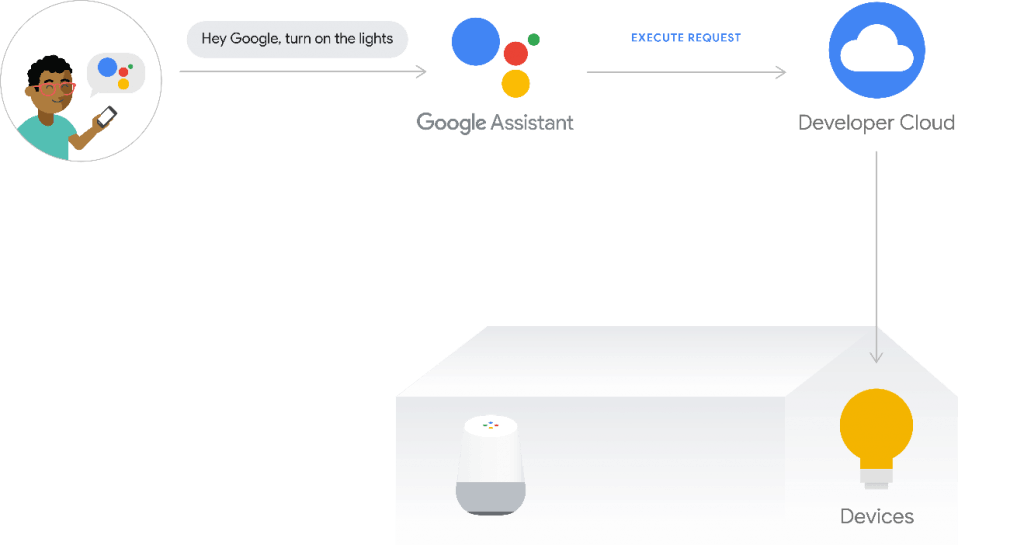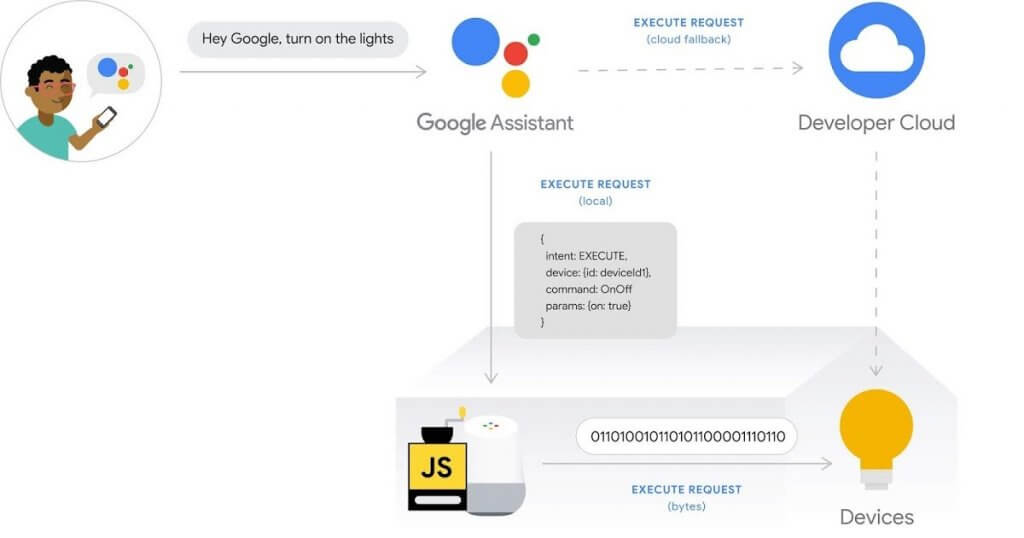Google Home using Google smart speaker as the core of system. With the help of a powerful Google Assistant virtual assistant platform, and create an ecosystem with the concept of Google smart home. The system can manage all the things in one place.
As a Google sub-brand, Google Nest is dedicated to the smart home market. This brand is an integration of the Nest originally acquired by Google and the Google Home brand created by Google. It includes all the smart home products produced by Google. In addition to the original Nest Thermostat, Nest x Yale Lock, Nest Cam, Nest Secure Alarm System and other products from Nest. And it also includes Google original products like WiFi router, Chromecast, Google Home Speakers and Google Display. After the integration, Google has launched other products such as Nest Audio, Nest WiFi and Nest Mini, etc. From the naming method, it is not difficult to see that Google is trying to replace the old Google Home with Nest.
The core products of Google Nest are Smart Speaker and Smart Display (Smart Speaker with Video Screen), and the greatest charm of these devices comes from their built-in voice assistant. With the help of Google Assistant, which is a powerful software platform, Google Nest products can control many different types of smart devices with different brands, therefore, a huge Google Home system is established together. In a sense, it can be said to be the soul of the entire system, while Google Nest’s products are the containers that carries it, and both complement each other and are indispensable.
History
Voice assistants and smart speakers are not Googleâs original, and many brands are far ahead of Google. The famous Siri was acquired by Apple as early as April 2010. After redevelopment, it became Appleâs exclusive voice assistant, while in November 2014, the Echo smart Speaker and Alexa were released at the same time by Amazon, and then it becomes more and more prosperous. Today, Amazon Alexa’s system has become very large.
As the first Google Assistant built-in smart speaker , the Google Home series came late in 2016. Although the timeline lags behind its competitors, the development speed of the Google Nest Speaker (formerly Google Home series) on the hardware is slightly slower than that of the Amazon Echo series, Google exerts its strong software development strength and rich platform development experience, it is developing extremely fast, in 2020, Google Assistant is already available on more than 1 billion devices.
Google HomeEcosystem
To build a Google Home system, at least a Google Smart Speaker or Smart Display, a Google account, and a mobile phone or tablet for configuration shall be available. The detailed requirements and configuration steps of Google Assistant is available on Googleâs official website Set up your Google Nest or Home speaker or display. After the setting is successful, this Google Speaker or Display device will serve as the control center of the entire system, and it saves the information of the room and smart devices connected in the database named Home Graph to facilitate the users to control various devices at home more easily.
Overview
At present, Google Home has two modes to process user requests.
One mode is through cloud computing, in which the user sends the request to the cloud. After analyzing the user request, the cloud sends instructions to the local device. The advantage of this mode is that you can remotely operate the entire system through the network, but the disadvantage is that obvious response delays often occur due to influence of the network environment.

The other mode is the edge computing method released in 2019, which can form a corresponding home local area network between devices with the Google Local Home SDK built-in. After the user issues an instruction, the data is identified, processed, and finally feedback execution all processed locally, which greatly improves the efficiency of device response, and it can control smart devices at home even when the network is disconnected.

The Local Home SDK makes up for the latency problem of pure cloud computing, and the additional benefit is that all information is stored locally without uploading to the cloud, and users do not need to worry about privacy information leakage. Although there are many advantages, however, at present, apart from Google Nest, not many brands actually use the SDK.
You can better understand the working principle of Google Home by the following diagram.
Cloud controlï¼?/p>
Local Home SDK
User Interface
In order to efficiently manage and control the Google Home System, you can choose to use the Google Assistant application for voice control or operate on the Google Home application interface. Both of these applications can be installed on many different types of devices to meet the needs of different scenarios in daily life.
Use voice
With a device with a built-in Google Assistant, you can easily use voice commands to complete various operations in daily life. A few words replace the complicated operations on the App interface, such as turning on the lights in the living room, controlling the cooling of the air conditioner, etc. The App of Google Assistant can be installed on Android, iOS, and Googleâs own Chrome devices. There is currently no official application that supports Windows.
Androidï¼?/p>
Google Assistant Go â?Lightweight version of Google Assistant
iOS:
Use App
For more complicated management operations, it may be more operative to use Google Home App, such as: batch management of devices, remote control of devices, viewing of historical surveillance videos, etc. Google Home supports Android devices and iOS devices, and you can find the app on Googleplay store or Apple app store.
Google Assistant
Google Assistant is a powerful voice assistant. Smart Home Control is just one aspect of its many functions. It is far more than just controlling a few smart devices. And the detailed descriptions of its functions are available on Googleâs official website, and they wonât be described here to avoid repetition. If you would like to learn more about Google Assistant/Smart speaker, please visit Google Assistant Overview and bellow links for more information:
Google Smart Speaker all features
Control smart home devices with Google Assistant
Privacy
Privacy is a major concern when we use online home intelligent systems. After all, Speaker and Cam are constantly monitoring all kinds of activities in our homes, and these electronic data are transmitted to the data storage of the service provider, so we need to know how the manufacturer ensure that our data will not be leaked or misused.
https://safety.google/intl/en_us/assistant/
https://nest.com/privacy/?utm_source=gstore&utm_medium=category&utm_campaign=connected_home
Country availability
For some reasons, Googleâs products and services are subject to national and regional restrictions. For example, some countries/regions have neither official product sales channels nor product support or services.
https://support.google.com/store/answer/2462844?hl=en
Hardware
Since Google Nest products are now integrated from two brands, it is inevitable that some products are with similar names and functions, which will confuse people who are new to Google Nest products. Here is a brief introduction to the classification and main functions of different Google Nest products.
Requirements for Google Nest and Chromecast devices
Hub Device
All systems need a control center and several types of devices are available to play this role for GoogleNest. Commonly used devices include Google’s smartspeaker, smartdisplay and the latest NestWi-Fi.
Here is a brief introduction to the differences between various control devices. The smartspeaker and google nest audio of the Google Home series and some devices with built-in smart speaker can only interact with voice, while the Nest Hub and NestHubMax are more maneuverable by their touch screens.
Google Nest speakers/displays compare
NestAudio
https://store.google.com/us/product/nest_audio
NestWiFi
https://store.google.com/us/product/nest_wifi
NestMini
https://store.google.com/us/product/google_nest_mini
NestHub
https://store.google.com/us/product/google_nest_hub
NestHubMax
https://store.google.com/us/product/google_nest_hub_max
GoogleHomeMini
https://store.google.com/us/product/google_home_mini_first_gen
Frankly speaking, the control center device is not limited to Google products. If you have enough hands-on ability and like challenge troubles, you can use the Raspberry Pi to DIY.
https://developers.google.com/assistant/sdk/guides/service/python
Operation terminalDevice
The Speaker or Display of Google Home has an obvious dual role of control center and operation terminal, so here is mainly to introduce simple operation terminal equipment, which is common mobile devices, such as smart phones, tablets, smart watches, etc. based on Android and iOS operating systems.
Google Nest Function Device
Google Nest also has some self-released functional devices, such as Nest thermostat, Nest x Yale Lock, NestCam, Nest Secure Alarm system and Nest Doorbell, etc., and since these devices are developed in accordance with the specifications set by Google, so compared to the same type of devices from other brands, these devices work more smoothly in the Google Home system. It is noted that although some devices have voice control functions, they do not have the ability to serve as a control center, so they can be replaced by non-Google brand devices in the entire system, therefore, I like to classify them as functional devices.
https://developers.google.com/assistant/smarthome/guides
Third-Party Compatible Device
Google Home is also compatible with various types of devices from other brands. After all, the smart home concept covers the entire home market, which includes all kinds of devices that we can see daily, which is far from being fully covered by any single company. How to judge whether a brand/device is compatible with Google Home? Google provides a list of compatible devices. It is noted that this list is not complete and it is just for your reference.
https://store.google.com/us/magazine/helpful_home
Paid Service
In addition to hardware products, GoogleNest also provides some services, such as one-time Pro installation, video and music subscription services to make it better, of course, these are all charged services.
Pro installation
Although many people tend to install GoogleNest devices by themselves, such as Smart Speaker devices with a simple installation process, as for specialized devices such as Nest x Yale Lock and Nest Thermostat, it still requires certain professional knowledge and skills, so GoogleNest also provides Proinstallation services (previously called Nest Proinstall) with latest fee of $99, and you can visit Google Pro installation for more information.
Subscriptions
Some advanced services, such as video entertainment, music, remote security, network storage, etc. are available for Chromecast, NestCam and Speaker, and the users need to subscribe and pay regularly to enjoy.
https://store.google.com/us/category/subscriptions
Resource
Google Smart Home Concepts
https://developers.google.com/assistant/smarthome/concepts
https://developers.google.com/assistant/smarthome/concepts/intents
Blog
https://blog.google/products/google-nest/
https://twitter.com/googlenest?lang=en
https://www.facebook.com/googlenest/
YouTube channel
https://www.youtube.com/user/Nest